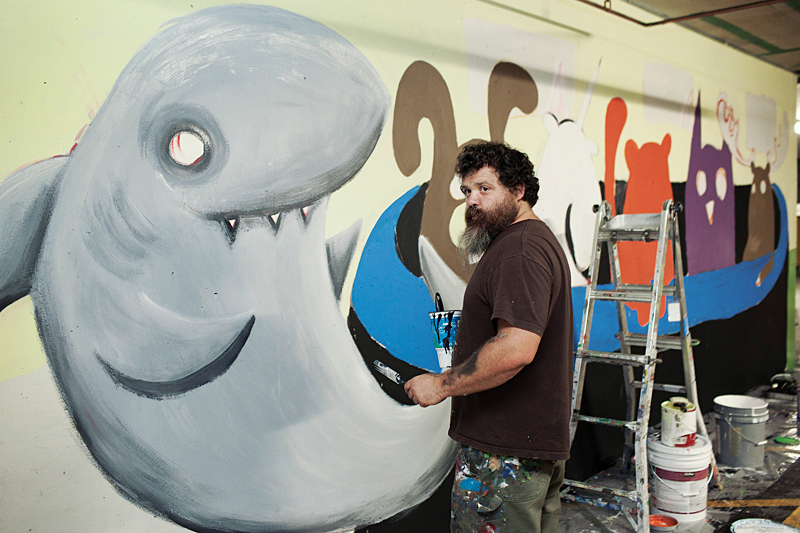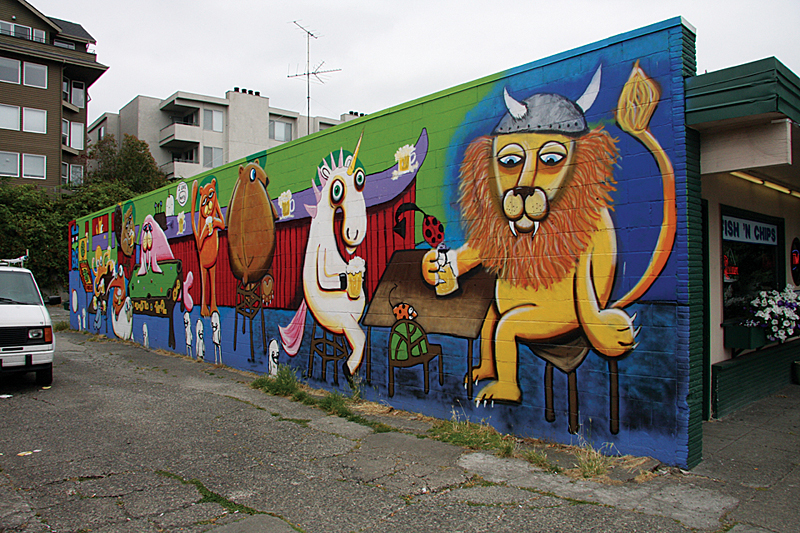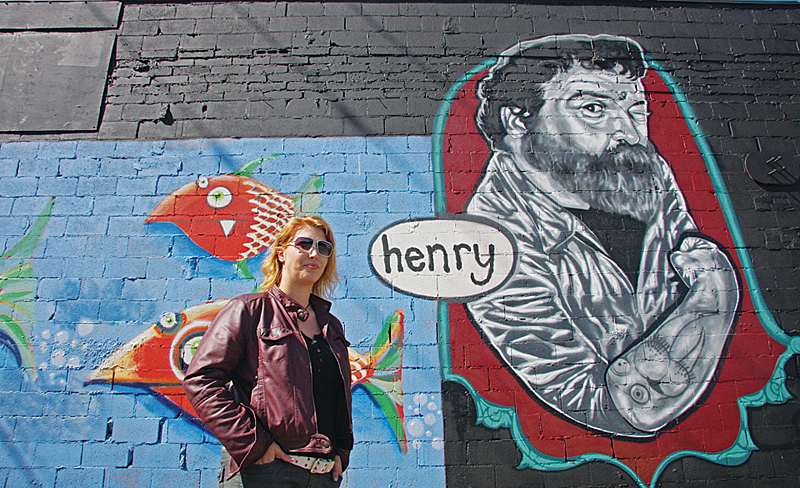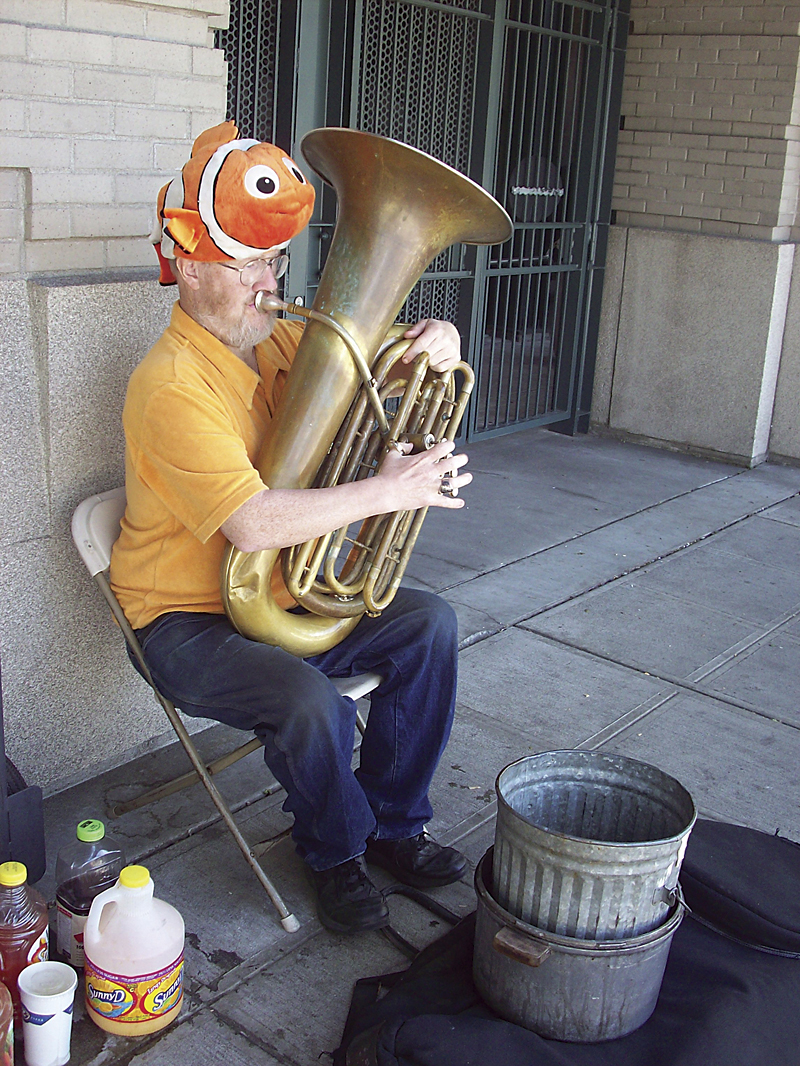Ryan Henry Ward knows why the cars are honking. They want him to jump.
It’s about 8 p.m., two weeks before the 2008 presidential election, and a light breeze flutters across the cool October night. Ward sits on the edge of a railing on the Alaskan Way Viaduct. A loose grip keeps him from plunging 60 feet onto the road below.
Like the traffic, his mind is a blur. He is convinced he is a raven and, like the mythological bird of Native American lore, has stolen the light of the world, helping usher in the apocalypse and the reign of Satan. In a moment, he will sprout wings and leap.
Drivers whir by as their headlights illuminate a heavily bearded man, about 5’8″ and 220 pounds, shielding himself from the chilly air with a red jacket, jeans, and a camouflage baseball cap. His feet, decked out in low-cut brown boots, dangle over the side of the Viaduct. Someone calls 911.
In nine minutes, a cop shows up and slowly approaches Ward. “Why are you up here, man?” he asks, according to SPD records and Ward’s own account. “I love God,” Ward says. The officer, fearing he’s about to witness a suicide, asks him if he feels like hurting himself. Ward stares at traffic and doesn’t reply. The officer grabs him.
Three years later, Ward says the ensuing trip to a mental hospital was the last time he needed serious psychological care. His imagination always ran rampant, but it was starting to get out of control. He needed a way to manage it, to release the building pressure.
Sipping from a steaming mug one recent morning at Ballard’s Short Stop Coffee, a favorite hangout where his work adorns the walls, Ward, 36, a soft-spoken teddy bear of a man who peppers his speech with “totally”s and “right on”s, says characters run rampant through his mind. There are brightly colored walruses, squids, and an eco-terrorist Sasquatch who likes sweatpants and nachos. A misunderstood witch appears dark, but has a loving side. “There’s a tenderness to her,” he says.
In three years, Ward has transformed himself from “Ryan” into “Henry,” Seattle’s most prolific muralist. More than 120 of his whimsical murals dot the city, populated by the colorful, cartoonish characters that reside in his brain. Typical of his style is a Ballard mural that features two huge, pink, polka-dotted walruses casually swimming, one lazily staring downward and the other, with big, bright eyes, looking toward a stream of air bubbles.
His murals are everywhere, all marked by his signature—simply “Henry,” his middle name and artistic alter ego. He’s also sold nearly 2,000 canvases, an amazing feat for someone who’s only been painting full-time since 2008. He says his customers include local celebrities like Amazon CEO Jeff Bezos, whom Ward claims bought one of his paintings at a charity auction. (Bezos declined comment through a spokesperson.) Like one of his characters, the Quadropus, a feisty octopus missing half its extremities, Ward’s reputation is quickly spreading its tentacles through the region.
His journey from well-off landscaper to full-time artist living in a small bus and stamping his image of cheer around the city is rooted in the transformational effects of unexpected tragedy and drug-induced insanity. It’s also the story of a guy who just likes to paint, his sudden rise to prominence, and critics who think his work is gooey, meaningless, and annoyingly prevalent.
Kevin McKouen remembers when Ward first stepped into his Fremont gallery, The Orange Splot, with a photo book containing 10 of his canvases. It was early in the summer of 2008, and Ward had been crossing the city trying to find a home for his work. Everyone so far had turned him down, until he stepped into McKouen’s gallery, open only a few months.
Contrary to his G-rated murals, Ward’s early work had a lot of nudity and was, by his own account, bizarre. “My first batch, there were a lot of wieners and boobs and stuff like that. It was different and weird at the time. It’s funny, because everybody that turned me down has got a hold of me since wanting to show my art, and I’m like, ‘Fuck you,’ ” he says, chuckling.
McKouen believes Ward’s work has a lightheartedness that people connect to. “The more I looked at [his art], the more I smiled,” he says. “I said, ‘If he’s making me this happy, he’s going to make other people happy, too.’ ” In a short time, Ward was The Orange Splot’s top-selling artist.
For the most part, the artist, like his murals, has a happy and whimsical personality. But both Ward and his work have a darker side that’s easy to miss. Not everybody sees it, but those who know him peer through the innocent veneer of his characters and see the influence of the paranoia and delusions he’s suffered on and off for almost two decades.
“One of my favorite paintings is this painting of a guy with one of the crazy, pointy-fingered hands Ryan does so well,” McKouen says. “He’s about to push a button, and in the background, spelled backward in a mirror, is the word ‘madness.’ It has a lightheartedness to it, but it definitely also has a dark side. You’re wondering what this button is, and you see the word—’madness’—and the look on the guy’s face. He doesn’t quite look like he knows what he wants to do.”
The Orange Splot closed in the fall of 2009, but Ward’s reputation had grown so fast by then that he had no trouble consistently selling canvases and getting commissions.
“Kevin even admitted at the beginning that he was worried nobody would really like it,” Ward says. “But it took off.”
Around midnight on a night in early August, Ward is preparing to leave the Ballard warehouse he shares with a dozen other artists. His rent is about $300 per month. Apart from his cell phone, that’s the only bill he has right now.
He parks his small bus, which doubles as his home, outside on the street, using the warehouse bathroom and bumming showers at friends’ nearby apartments. It’s a lifestyle choice, as he could certainly afford an apartment.
Ward hops into his brightly painted 1990 Subaru Legacy, which runs faithfully even as it nears 200,000 miles. He steers it, sputtering loudly, toward Capitol Hill. A box of 5,000 stickers has just arrived, and Ward and his nearly silent, 26-year-old bearded assistant, Josh Knigge, want to paper them all over the neighborhood.
Knigge met Ward when he and an ex-girlfriend asked him to paint their Legacy. The romance didn’t last, but Knigge’s ex, a fan of Ward’s, gave him the car as a gift.
Ward and Knigge stroll down 15th Avenue East, smoothing stickers onto the back of street signs and the sides of bike rails. Ward is the anti-hipster, clad in sandals, large green gym shorts with white lines running down the middle, and an open flannel shirt covering a black T-shirt that hides his belly. While the stickers he puts up are promotional—most list his website, ryanhenryward.com, and many have his distinctive “Henry” signature—he never puts them on businesses and never covers other artists’ stickers.
Though Ward is known primarily for his murals, he’s also a member of a community of about 40 artists who actively post their stickers around the city, according to Dave Bloomfield, whom Ward calls Seattle’s most prolific street artist. Most of these artists have street names, like Tingler and Narboo. It’s easy to overlook their work, but once you start to pay attention, it’s surprisingly widespread—what appears to be a random penguin sticker doesn’t seem like much until you see it stuck to signs all over the city. A pattern develops, and as you wind through Seattle, you wander a maze of subliminal art asking to be seen but not scraped off.
Bloomfield says most of his stuff, like Ward’s murals, is intended to lift the spirits of passersby. “The hope is if someone is bummed and walking down the street and they see this little character, they’ll laugh or at least get a little smile going,” says Bloomfield, whose street name is Starhead Boy, and whose ubiquitous stickers often feature small, elemental figures that would be at home amid cave drawings.
Tonight, the temperature is warm enough for Ward and Knigge to stroll comfortably around the Hill without a jacket. Music emanates from bars and small groups watch from a distance as the two wind their way through the neighborhood. Around 1 a.m., they decide to “double-dog it,” and both dish out $10 for two hot dogs slathered in cream cheese and onions.
As they stand off to the side to eat, a man, who appears to be homeless and is mumbling under his breath, approaches and starts talking with Ward. He too has a hot dog, and small gobs of cream cheese drip down onto his weathered face and gray beard.
“What you doing?” he asks.
“I’m an artist,” Ward says. “The stickers express my work. Want a sticker?”
The homeless guy nods. An awkward silence ensues before Ward moves on and puts a sticker on a nearby pole.
With the possible exception of his stickers, most of what Ward does can’t be considered street art. All 120 murals have been painted with the property owners’ permission. But, he says, Seattle is an easy city for full-time street artists to put up work without getting noticed, because most people are in their own little bubble, shuffling around from place to place, texting on their cell phones. If they looked up, they’d gain a new perspective.
It’s a statement Ward applies to himself. “You could go, ‘Oh, that looks like a retarded bird,’ ” he says. “But once you realize what the person is like who made the retarded bird and why he did it, you can kind of understand it’s not just a retarded bird.”
Born in Montana, Ward moved as a young boy to Enumclaw, where he grew up with his parents and two brothers. He was shy and didn’t really fit in at school. His dad, Don, 56, remembers him as the type of kid who would finish a test before all his classmates and then doodle all over the page.
Following graduation, he attended Fairhaven College, a small liberal-arts school that’s part of Western Washington University. Students at the Bellingham campus don’t get typical letter grades, instead earning a narrative evaluation. They can design a degree program of their choosing, something Ward took advantage of by pursuing a bachelor’s in writing, art, and storytelling for children.
After he left Fairhaven, Ward worked as a social worker, helping at-risk kids, AIDS patients, and developmentally disabled people. Like many social workers who work with troubled kids, Ward was attacked several times. To defuse tense situations, he began to introduce art, which provided a release for his pupils’ nervous, pent-up energy. Later in life, he’d revisit the idea of art as therapy, this time for himself.
As they entered their 20s, Ward and his two siblings, Andy and Brandon, roomed together in Bellingham. Ward was especially close to Brandon, his older brother. “They were a year and a half apart, so they were almost like twins,” younger brother Andy says.
Then, on Sept. 9, 1999, Brandon, only 25, died of heart failure. Doctors had detected the condition, but Brandon decided he didn’t want a transplant. “He didn’t want someone else’s heart in his body,” Ward says, looking at his feet. “He was a stubborn motherfucker.”
Grief-stricken, the two surviving brothers traveled to India, Nepal, and Thailand, staying busy to distract from an ever-present sadness. Four months later, they returned to the U.S. But as Andy eased back into the ebb and flow of life, his brother hopped on a plane and went to Africa. “I got married and he kept traveling,” Andy says.
Ward’s dad, who still lives in Enumclaw and works in the metal fabrication and distribution business, noticed a big personality change in his son. “Ryan became way more philosophical, way more interested in finding the meaning of life,” he says.
Six years later, Ward started to burn out professionally. He was on the verge of marrying a fellow social worker, and wanted a change of pace. His fiancee eventually changed her mind and the engagement was called off, but Ward still left social work to work for a landscaping company with his brother. Before long, they split off and formed their own company.
By early 2007, business was doing well. Flush with money, Ward dropped $13,000 on a new off-road four-wheeler, the biggest one in the shop. “You could pull a moose out of the forest with it,” he says.
To celebrate, Ward and his brother traveled with friends to Moses Lake, where, after a few too many drinks, they decided to embark on a race. Their vehicles spat out sand as they took sharp turns and sped across some dunes. As the group approached a 10-foot cliff, Andy and the others leapt off, thudding down on the sand below. Ward followed on his ATV, but it was too bulky: As he plunged off the cliff, he flipped over the handlebars, suspended in midair for a split second before the 900-pound vehicle came crashing down on him.
“It actually whiplashed my spine and I was stuck under this thing,” he says. “I watched everyone’s lights go off—whoosh—in the distance.”
Ward lay smashed in the sand. As his breaths grew more infrequent and shallow, he had an epiphany. He laughed at how stressed he was and vowed to change his life.
“It was ironic I was dying that way, because I’ve been anti-redneck my whole life,” he jokes. “And here I was, dying in a four-wheeler accident, under this big redneck machine.”
He was saved when a 16-year-old boy saw him trapped and ran over. “Some little guy, a 150-pounder, came and flipped the bike off him,” Andy says. “He was buried in the sand for 20 or 30 minutes.”
Lacking health insurance, Ward avoided a hospital trip and went home. With access to black-market pills, he self-medicated with Oxycontin and muscle relaxers. Cooped up in bed, his characters started to express themselves more often, begging to break out of the confines of his brain and into the physical world. Some, like the walrus, reflected Ward.
“I was kind of walking around like a walrus, on my stomach, and I identified with it really strongly,” he says. “I actually tattooed it on myself.”
At the end of a trying year, Ward emerged a different man. After a brief attempt to start a band, he decided to paint full-time, and began to stress much less over small things. But his Catholic upbringing made him feel guilty about the way he was leading his life.
“Being raised Catholic, you kind of get guilt-tripped,” he says. “My mom’s always trying to make me feel guilty about everything. Not visiting enough, always feeling like you’re not good enough, or you’re not quite doing enough—that kind of thing. I felt like I could be doing more with my life.”
On a sunny afternoon in July, Hera Won, a 33-year-old aerosol artist who specializes in portraits, sits in a parking lot near Fourth Avenue South and South Holgate Street in Seattle’s SoDo neighborhood. Feeling the heat, she moves into the shade.
Won met Ward in 2009, and they quickly became friends. Earlier this year, Won came up with an intriguing idea: “Why not paint a mural of Henry next to one of his own murals?” she thought.
The result was a 20-foot-high painting of Ward that sits adjacent to one he did of a smiling child with closed eyes riding a giant, bug-eyed orange fish. Won points across the parking lot to the mural and describes her friend’s motivation. “The way he explains it to me is he wanted to do something for the average 5-year-old walking around Seattle, that you turn the corner and, boom, there’s a unicorn playing a banjo or a walrus riding a bike, and that just kind of jump-starts the imagination,” she says.
When he paints a mural, Ward starts by putting up a rough sketch of a design on a wall. He steps back and looks at it a few times. If it looks right, he starts to fill in the outline. The most important part of the process is figuring out what he should paint. Sometimes it’s influenced by his mood, sometimes by location—a giant squid staring at a diver on the back of a dive shop, for instance.
In the beginning, Ward painted with big, aggressive brushstrokes. “I just liked the raw energy of it,” he says. As time progressed, however, he began to incorporate more detail. Now he usually spends several days on each mural, often driving by the location beforehand to brainstorm.
Around 1:30 a.m. on the night Ward pastes Capitol Hill, a young, bulky black guy, who appears to be a bouncer, bounds down the street. “Yo, dude, your shit is sick,” he says. “Don’t listen to the graffiti kids talking shit.”
Ward looks up, thanks the man, and gives him a sticker. He runs back up the street to his perch outside the bar. Who are the graffiti kids? “There’s definitely, like, white-gangster, fake-gangster 14-year-old boys in Ballard that don’t like my stuff,” Ward says.
But the graffiti kids aren’t his only haters. Former P-I art critic Regina Hackett bashed Ward last year, calling his murals “brain-dead cheer.” A battle ensued in the comments section, with critics classifying Ward’s work as sugary, overly simplistic, and childish. “Henry has shat his hack illustrations over almost every corner of our city, reducing our public space to a granola-inspired elementary-school lunchroom,” wrote a commenter who identified himself as Bryan Feddern.
Won thinks some of Ward’s critics are just jealous. He’s figured out how to do what many of them strive for: He puts his stuff all over the city; people approach him on the street saying how much they love his work; and he makes good money making it.
Victoria Ellison, a mixed-media artist who’s written art criticism for this paper and who now lives in Los Angeles, says Ward’s murals don’t hurt anyone, but they’re just not that interesting. There is some talent in the variation of his patterns and his composition can have some wit, she says, “but mostly, it’s very ordinary, unprofessional cartooning, not especially ambitious or well-drawn—just a coloring-book kind of a blending of popular influence: the Maurice Sendak teeth, Sesame Street–like monsters, etc. But his message is generally good-hearted.”
Ward argues that he’s not trying to be either an “outside” or “inside” artist. His work, it’s worth noting, even hangs in the Wedgwood branch of U.S. Bank. “I’m not trying to revolutionize the art world,” he says. “I’m more focused on expressing what feels right from my soul.”
Rather than play the part of a brooding, moody artist, Ward smiles often and says he has good friends and a career he loves. It takes some prying to get details on the darker moments of his life.
Andy was in middle school the first time his brother made a trip to the mental hospital. Ward says he took 17 hits of acid at the time: “I was pretty much tripping for six weeks.”
Ward’s dad says all his son’s episodes, to his knowledge, have been drug-induced, but Ward says he stopped taking acid in college and has simply suffered from flashbacks and complications from earlier drug-induced psychoses. He’s also been diagnosed with bipolar disorder.
At one point, he thought Woody Allen was trailing and covertly filming him. He wasn’t on drugs at the time, he says. “I thought Woody Allen had bought all the cameras in Seattle, somehow made a deal with Paul Allen,” he says. One day, Ward exploded in front of people at Golden Gardens. “It was like real life. People would walk by me and say things, and I thought they were saying things like, ‘I saw that guy on TV last night.’ “
At various points, doctors prescribed lithium and a host of antipsychotic drugs for Ward. On medication, he says, his creativity disappeared. So art became his medicine, his murals and canvases both refuge and career.
“It’s kind of crazy,” he says.
Craig Mathews and his partner, Shawn Smith, suffered a major health scare last year when Smith collapsed after an intense workout. “He walked into a locker room, just passed out, and his heart stopped,” Mathews says.
Smith, a 40-year-old manager at Sutter Home and Hearth in Ballard, had no family history of heart problems, so the episode deeply disturbed the couple. He spent a week recovering in the hospital. To celebrate his recovery, Mathews, 37, asked Ward to paint a portrait of the couple, who live on First Hill with their two cats.
“We wanted something to commemorate our little family,” says Mathews, a manager for the Washington State Dental Association.
Ward, who’s never far from Merlin, his bushy, black-and-white border-collie mix, paints portraits of pets on commission, but typically shies away from painting people. “I think the reason he did it was because Shawn went to the hospital last year,” Mathews speculates, unaware that Ward’s brother died from a similar heart condition.
In the painting, Mathews and Smith show toothy smiles and bright blue eyes. Framing the couple are their two cats, a peach Siamese stretched out above their heads, and a black-and-white one below. “The look is kind of quirky,” Mathews says. “You know exactly who painted it. I know now he does a lot of those darker images as well, but they’re fun, they’re bright.”
As he walks down 15th Avenue, Ward pauses to lean on a blue Employment Guide box, twisting and stretching his back. Bouts of pain linger from the four-wheeling accident, preventing him from skateboarding, as he used to, and limiting his physical activity. (His car sports a handicapped permit.) Asked if he misses his anonymity, he says the attention is cool, and the money is nice because it allows him to live a life free of the obligations that slow the rest of the world. But, he says, his real motivations are simpler.
For people like Mathews and Smith, Ward’s work is a reminder of the brighter side of life. With the headlines dominated by a faltering economy and bouts of unrest around the world, Ward’s murals aren’t meant to capture the zeitgeist, but to inject a dose of cheer. Whether his characters make you smile or drive you to poke your eyes out with a fork, they’re watching you as you zip around the city, and their numbers are growing.








